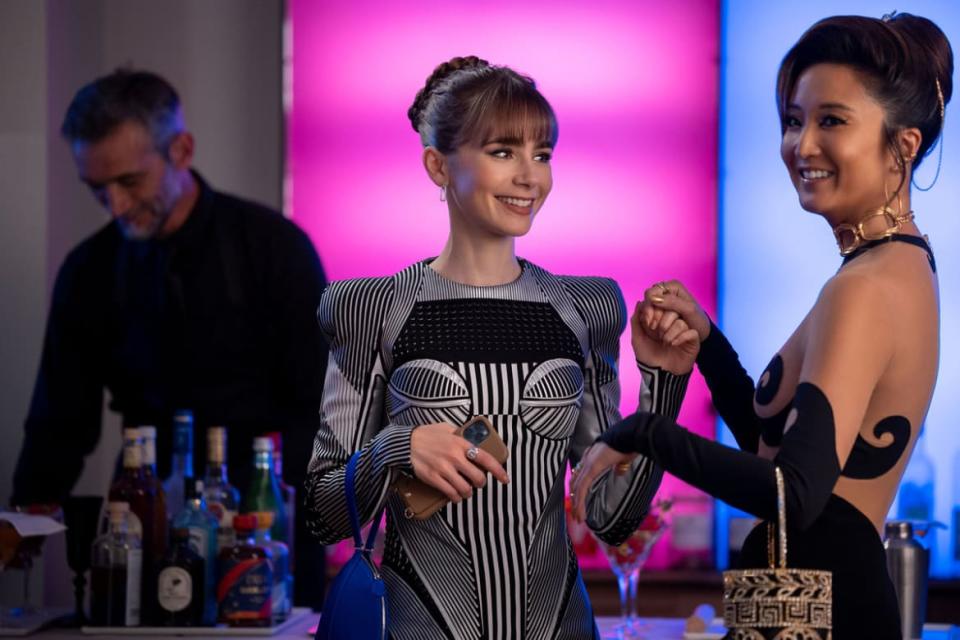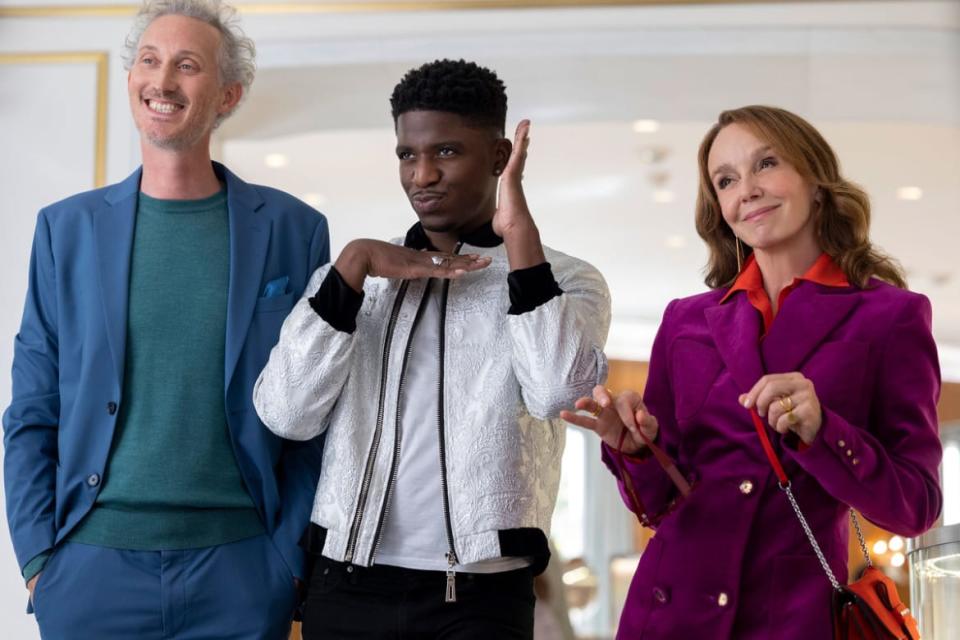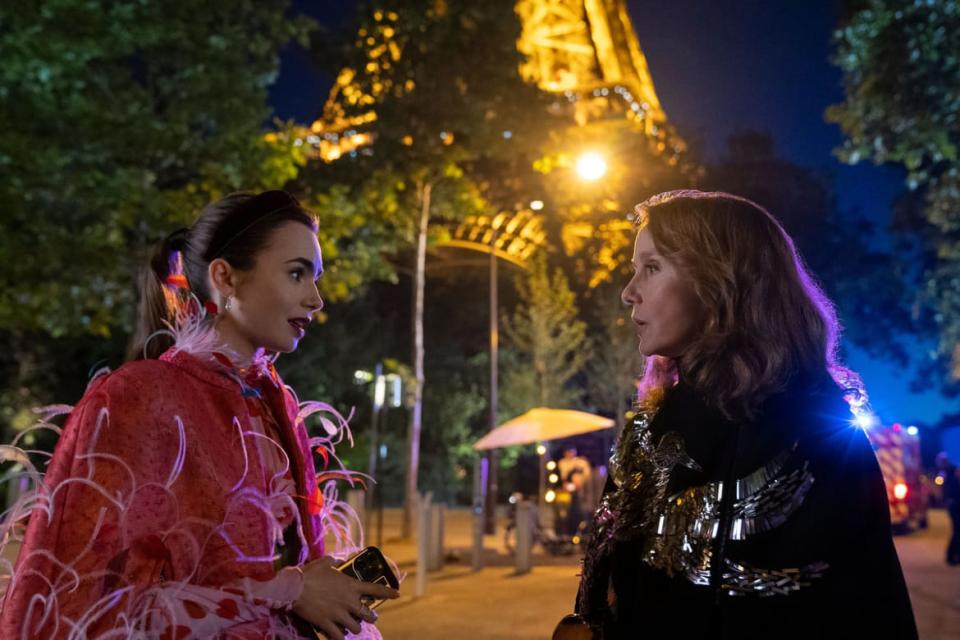‘Emily in Paris’ Is More Wonderfully Ridiculous Than Ever

- Oops!Something went wrong.Please try again later.
- Oops!Something went wrong.Please try again later.
- Oops!Something went wrong.Please try again later.
The French have a saying, one that perfectly fits a show like Emily in Paris: “Plus il y a de pandémonium, mieux c’est.” In English, this roughly translates to, “The more pandemonium, the better.” Why not have a confrontation on the top of the Eiffel Tower, wear a mess of colors that don’t work together, and make McDonalds burgers on baguettes?
Sike. That saying is totally made up, but it is a phrase that popped into my head while watching Season 3 of Emily in Paris. It came straight from Google Translate; I don’t speak French. But this is what watching Emily in Paris now feels like after three seasons: Darren Star invents his own version of Paris and sends it through a translator that works 50 percent of the time. And you know what? Somehow, it works.
Each new season of Emily in Paris somehow feels like the same story is being repeated again, and yet somehow a completely different show. The plots are the same—every single character is in a love triangle at this point, with the Emily (Lily Collins)/Gabriel (Lucas Bravo)/Camille (Camille Razat) entanglement still ongoing—but the format keeps being reinvented. Emily is obsessed with being an influencer and posting to Instagram in the first season, but by Season 3, we rarely get to see her iconic chunky camera phone case.
Sure, the chocolate croissant Insta posts are missed (and so are Emily’s tongue-in-cheek captions), but the evolving formula leaves room for dopey new escapades with the same Emily in Paris sheen.

Lily Collins as Emily, Philippine Leroy-Beaulieu as Sylvie Grateau in episode 301 of Emily in Paris.
Emily’s boss Madeline (Kate Walsh) is still pregnant. Everyone goes on a vacay together to the South of France. Camille and Gabriel are together, but Gabriel can’t deny his chemistry with Emily. Sylvie (Philippine Leroy-Beaulieu) hates Emily’s guts. One might compare Emily in Paris to an epic poem: There’s a reliable narrative formula and extraordinary characters who are nearly devoid of human characteristics.
You might want to know more about the plot for Emily in Paris Season 3, but describing the wild new storylines feels more impossible than stealing the Mona Lisa. Let’s start where we left off: Emily’s Chicago boss Madeline has fired Sylvie, who now plans to launch her own marketing agency with the clients she met at Savoir. Emily will join Sylvie’s company and leave Savoir, but hasn’t told her (very pregnant) boss yet and is afraid to break the bad news. The new season opens on this scene. Her two bosses confront her on the top of the Eiffel Tower—so chaotic and, at the same time, so brilliant.
Bravo’s ‘Real Girlfriends in Paris’ Wants What ‘Emily in Paris’ Has
Without spoilers, by the end of the season, you'll have completely forgotten about this conflict. It’s resolved in a matter of two episodes, so that we can get to the real juicy parts of the show: the romance. Gabriel and Camille are totally back together, while Emily and Alfie are sorting out their fledgling relationship. Mindy (Ashley Park) is still seeing that guy who happens to be a performer in her band. Even Sylvie has two men, her husband and another younger fellow. By the end of the season, you’ll be shocked to see how much of this shifts around, like tectonic plates rupturing the entire dating ecosystem in Paris.
Though you’d imagine a show this frothy and fun would never be taken too seriously, Emily in Paris has faced a slew of controversies in its two seasons at Netflix. The first season received blowback for its trite and clichéd depiction of Parisians, as well as for its controversial nominations at the Golden Globes (which it allegedly received after flying voters out to France for a lavish party).

Bruno Gouery as Luc, Samuel Arnold as Julien, Philippine Leroy-Beaulieu as Sylvie Grateau in episode 302 of Emily in Paris.
The reaction after the second premiered was worse. A scene involving a Ukrainian character who stole from stores, which earned plenty of backlash for fostering negative stereotypes. Even Chicago’s Lou Malnati’s started a war with Emily, who bashed their deep dish pizza in the very first episode. Undoubtedly, Season 3 will face some issues—though, luckily, nothing seemed deeply offensive upon my first viewing. This is how Emily in Paris should be: unproblematic, stupid, and fun.
The campaigns Emily works on are always a delight, from putting a bedroom in the Louvre to “le vagin n’est pas masculin!” Season 3 is no different, with marketing stunts that range from McDonalds’ “McBaguette” launch to the trusty Champere (the show’s fictional cheap champagne) account, which enters the world of canned cocktails via a tasty Kir Royale drink. Just like Emily, Netflix has also upped their marketing for this new season, with pop-up markets in NYC and an official companion book. It’s a little surprising to see that, alongside massive hits like Stranger Things, this wacky show has become one of Netflix’s most prominent titles.

Lily Collins as Emily, Ashley Park as Mindy in episode 308 of Emily in Paris.
There’s good reason for it to rank among series like Bridgerton and Squid Game in popularity, even if it’s not as traditionally “artistic” as they’re praised for being.. (Seeing Emily expose her tummy in every episode with a new bedazzled crop top and miniskirt isn’t exactly peak fashion design, for example, but those kooky outfits are blessed!) Watching Emily in Paris feels akin to playing The Sims, in which your character (Emily, in this case) enters a society, meets its residents, and becomes the center of attention. These characters have no other friends, and Emily immediately becomes one of their closest confidants. Why? Who cares? Nothing makes sense. And thank goodness.
Emily in Paris does not measure up to the intelligence and wittiness of The White Lotus, but, god, I did laugh just as hard while watching both of them. There’s not much difference; in both, we’re watching foolish people be foolish and have affairs, all while traipsing through Europe with a glass of wine in hand. There’s something special about Emily in Paris that no other show has. Maybe it’s the amount of times the characters shout “Emily” at the lead character, or maybe it’s the rest of the completely unlifelike dialogue. We should all be grateful to live in a time when “I need the whole crepe” makes its way into our vernacular. Now, let’s see what goes viral from Season 3.
Get the Daily Beast's biggest scoops and scandals delivered right to your inbox. Sign up now.
Stay informed and gain unlimited access to the Daily Beast's unmatched reporting. Subscribe now.

